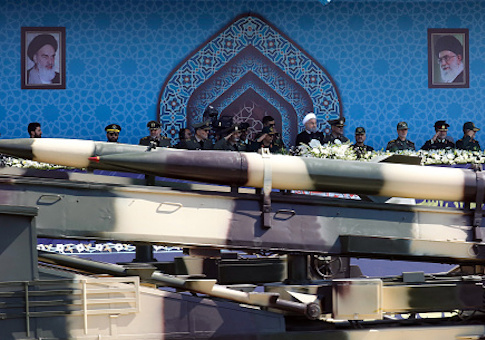A team of California-based weapons researchers has uncovered evidence suggesting Iran is developing long-range missile technology at a secret facility in the Iranian desert.
Recent Iranian state television programs memorialized the late Gen. Hassan Tehrani Moghaddam, a military scientist who was killed in a massive explosion at Iran's major missile base near Tehran in November 2011. Researchers at the Middlebury Institute of International Studies at Monterey, California, reviewed the footage and came across what they say is evidence of a second missile facility operating to this day, the New York Times reported Wednesday.
The researchers also examined satellite photos of the facility and believe work at the site is currently focused on advanced rocket engines and rocket fuel.
The work is often done at night and may be geared to develop long-range missiles, according to the Times.
It is possible that the facility is developing only medium-range missiles, which Iran already possesses, or perhaps an unusually sophisticated space program.
But an analysis of structures and ground markings at the facility strongly suggests, though does not prove, that it is developing the technology for long-range missiles, the researchers say.
"Five outside experts who independently reviewed the findings agreed that there was compelling evidence that Iran is developing long-range missile technology," New York Times correspondent Max Fisher wrote.
Michael Elleman, a missile expert at the International Institute for Strategic Studies, reviewed the material and said the "investigation highlights some potentially disturbing developments." He explained it could show preliminary steps "for developing an ICBM [intercontinental ballistic missile] five to 10 years down the road, should Tehran wish to do so."
Such a program, however, would not violate the Iran nuclear deal. President Donald Trump recently withdrew the U.S. from the multilateral agreement, reimposing economic sanctions despite opposition from European allies.
The researchers found satellite imagery evidence of an increasing number of buildings at Shahrud, the site of a missile test launch in 2013 considered dormant ever since. They found the buildings were painted aquamarine, the same color Moghaddam had the first facility where he was killed painted.
Shahrud is named for a town in Iran 40 kilometers away.
The researchers also discovered near the buildings what they considered "ground scars," strong evidence of the burning of outdoor missile tests. One appeared in 2016, another in 2017, the latter of which the experts believe powered between 62 and 93 tons of thrust, enough for an ICBM.
Other evidence includes human activity suggesting a major subterranean underground facility and circumstantial proof that the facility is using "solid fuel," which has significant military applications. Solid-fueled missiles, unlike liquid-fueled ones, do not need to be filled right before launch and thus can be hidden in remote places, the Times noted.
One expert quoted by the Times speculated Iran is developing long-range missiles as a precaution. Jeffrey Lewis, the leader of the California researchers, said world powers should not underestimate how quickly Iran could develop such technology, comparing it to North Korea's rapid ICBM development.
"The Iranians are choosing to restrain themselves for political reasons, and if we tell them to go to hell, we're not going to like what they do," Lewis said.
